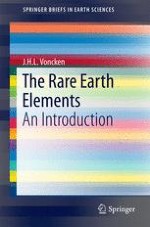2016 | OriginalPaper | Chapter
3. Physical and Chemical Properties of the Rare Earths
Author : J. H. L. Voncken
Published in: The Rare Earth Elements
Publisher: Springer International Publishing
Activate our intelligent search to find suitable subject content or patents.
Select sections of text to find matching patents with Artificial Intelligence. powered by
Select sections of text to find additional relevant content using AI-assisted search. powered by
